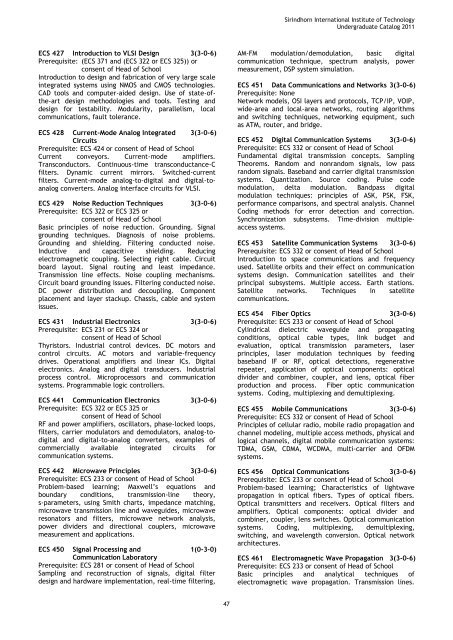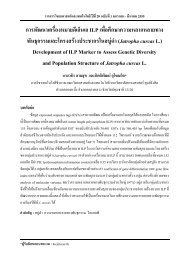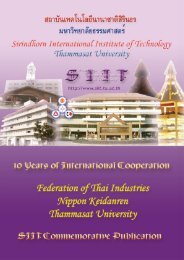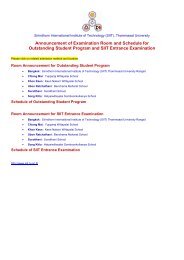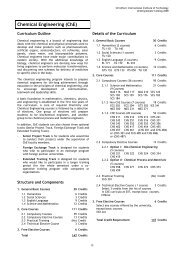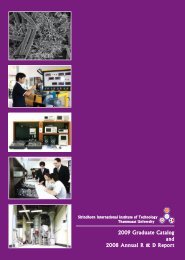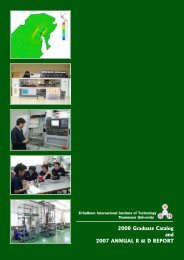Undergraduate Catalog, Academic Year 2011 - Sirindhorn ...
Undergraduate Catalog, Academic Year 2011 - Sirindhorn ...
Undergraduate Catalog, Academic Year 2011 - Sirindhorn ...
You also want an ePaper? Increase the reach of your titles
YUMPU automatically turns print PDFs into web optimized ePapers that Google loves.
<strong>Sirindhorn</strong> International Institute of Technology<br />
<strong>Undergraduate</strong> <strong>Catalog</strong> <strong>2011</strong><br />
ECS 427 Introduction to VLSI Design 3(3-0-6)<br />
Prerequisite: (ECS 371 and (ECS 322 or ECS 325)) or<br />
consent of Head of School<br />
Introduction to design and fabrication of very large scale<br />
integrated systems using NMOS and CMOS technologies.<br />
CAD tools and computer-aided design. Use of state-ofthe-art<br />
design methodologies and tools. Testing and<br />
design for testability. Modularity, parallelism, local<br />
communications, fault tolerance.<br />
ECS 428 Current-Mode Analog Integrated 3(3-0-6)<br />
Circuits<br />
Prerequisite: ECS 424 or consent of Head of School<br />
Current conveyors. Current-mode amplifiers.<br />
Transconductors. Continuous-time transconductance-C<br />
filters. Dynamic current mirrors. Switched-current<br />
filters. Current-mode analog-to-digital and digital-toanalog<br />
converters. Analog interface circuits for VLSI.<br />
ECS 429 Noise Reduction Techniques 3(3-0-6)<br />
Prerequisite: ECS 322 or ECS 325 or<br />
consent of Head of School<br />
Basic principles of noise reduction. Grounding. Signal<br />
grounding techniques. Diagnosis of noise problems.<br />
Grounding and shielding. Filtering conducted noise.<br />
Inductive and capacitive shielding. Reducing<br />
electromagnetic coupling. Selecting right cable. Circuit<br />
board layout. Signal routing and least impedance.<br />
Transmission line effects. Noise coupling mechanisms.<br />
Circuit board grounding issues. Filtering conducted noise.<br />
DC power distribution and decoupling. Component<br />
placement and layer stackup. Chassis, cable and system<br />
issues.<br />
ECS 431 Industrial Electronics 3(3-0-6)<br />
Prerequisite: ECS 231 or ECS 324 or<br />
consent of Head of School<br />
Thyristors. Industrial control devices. DC motors and<br />
control circuits. AC motors and variable-frequency<br />
drives. Operational amplifiers and linear ICs. Digital<br />
electronics. Analog and digital transducers. Industrial<br />
process control. Microprocessors and communication<br />
systems. Programmable logic controllers.<br />
ECS 441 Communication Electronics 3(3-0-6)<br />
Prerequisite: ECS 322 or ECS 325 or<br />
consent of Head of School<br />
RF and power amplifiers, oscillators, phase-locked loops,<br />
filters, carrier modulators and demodulators, analog-todigital<br />
and digital-to-analog converters, examples of<br />
commercially available integrated circuits for<br />
communication systems.<br />
ECS 442 Microwave Principles 3(3-0-6)<br />
Prerequisite: ECS 233 or consent of Head of School<br />
Problem-based learning; Maxwell’s equations and<br />
boundary conditions, transmission-line theory,<br />
s-parameters, using Smith charts, impedance matching,<br />
microwave transmission line and waveguides, microwave<br />
resonators and filters, microwave network analysis,<br />
power dividers and directional couplers, microwave<br />
measurement and applications.<br />
ECS 450 Signal Processing and 1(0-3-0)<br />
Communication Laboratory<br />
Prerequisite: ECS 281 or consent of Head of School<br />
Sampling and reconstruction of signals, digital filter<br />
design and hardware implementation, real-time filtering,<br />
AM-FM modulation/demodulation, basic digital<br />
communication technique, spectrum analysis, power<br />
measurement, DSP system simulation.<br />
ECS 451 Data Communications and Networks 3(3-0-6)<br />
Prerequisite: None<br />
Network models, OSI layers and protocols, TCP/IP, VOIP,<br />
wide-area and local-area networks, routing algorithms<br />
and switching techniques, networking equipment, such<br />
as ATM, router, and bridge.<br />
ECS 452 Digital Communication Systems 3(3-0-6)<br />
Prerequisite: ECS 332 or consent of Head of School<br />
Fundamental digital transmission concepts. Sampling<br />
Theorems. Random and nonrandom signals, low pass<br />
random signals. Baseband and carrier digital transmission<br />
systems. Quantization. Source coding. Pulse code<br />
modulation, delta modulation. Bandpass digital<br />
modulation techniques: principles of ASK, PSK, FSK,<br />
performance comparisons, and spectral analysis. Channel<br />
Coding methods for error detection and correction.<br />
Synchronization subsystems. Time-division multipleaccess<br />
systems.<br />
ECS 453 Satellite Communication Systems 3(3-0-6)<br />
Prerequisite: ECS 332 or consent of Head of School<br />
Introduction to space communications and frequency<br />
used. Satellite orbits and their effect on communication<br />
systems design. Communication satellites and their<br />
principal subsystems. Multiple access. Earth stations.<br />
Satellite networks. Techniques in satellite<br />
communications.<br />
ECS 454 Fiber Optics 3(3-0-6)<br />
Prerequisite: ECS 233 or consent of Head of School<br />
Cylindrical dielectric waveguide and propagating<br />
conditions, optical cable types, link budget and<br />
evaluation, optical transmission parameters, laser<br />
principles, laser modulation techniques by feeding<br />
baseband IF or RF, optical detections, regenerative<br />
repeater, application of optical components: optical<br />
divider and combiner, coupler, and lens, optical fiber<br />
production and process. Fiber optic communication<br />
systems. Coding, multiplexing and demultiplexing.<br />
ECS 455 Mobile Communications 3(3-0-6)<br />
Prerequisite: ECS 332 or consent of Head of School<br />
Principles of cellular radio, mobile radio propagation and<br />
channel modeling, multiple access methods, physical and<br />
logical channels, digital mobile communication systems:<br />
TDMA, GSM, CDMA, WCDMA, multi-carrier and OFDM<br />
systems.<br />
ECS 456 Optical Communications 3(3-0-6)<br />
Prerequisite: ECS 233 or consent of Head of School<br />
Problem-based learning; Characteristics of lightwave<br />
propagation in optical fibers. Types of optical fibers.<br />
Optical transmitters and receivers. Optical filters and<br />
amplifiers. Optical components: optical divider and<br />
combiner, coupler, lens switches. Optical communication<br />
systems. Coding, multiplexing, demultiplexing,<br />
switching, and wavelength conversion. Optical network<br />
architectures.<br />
ECS 461 Electromagnetic Wave Propagation 3(3-0-6)<br />
Prerequisite: ECS 233 or consent of Head of School<br />
Basic principles and analytical techniques of<br />
electromagnetic wave propagation. Transmission lines.<br />
47


